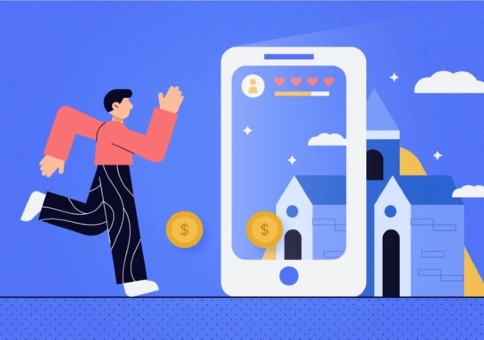How Fintech App Development Is Changing the Banking Industry
From the way customers interact with their banks to how financial services are delivered, fintech development has fundamentally reshaped the banking landscape. In this article, we’ll explore how fintech is changing the banking industry, delve into key trends, and provide insights backed by real-world data.
The Rise of Fintech: A Market Overview
The global fintech market has been expanding at an unprecedented rate, reflecting a significant shift in how financial services are delivered and consumed. According to a report by Fortune Business Insight, a compound annual growth rate (CAGR) of 21.78% is expected from 2022 to 2028, which is a lot. This rapid growth is driven by several factors, including the following:
- Smartphone Penetration: The proliferation of smartphones, with over 6.8 billion users worldwide as of 2023, has significantly enhanced the accessibility of mobile banking and fintech apps, fueling the growth of the fintech market.
- Consumer Expectations: Fintech apps are uniquely positioned to meet modern consumers' demands for convenience, speed, and personalization.
- Regulatory Support: Governments and regulatory bodies increasingly support fintech innovations, recognizing their potential to drive financial inclusion and economic growth.
As a result of these developments, traditional banks are no longer the sole gatekeepers of financial services. Agile and innovation-driven fintech startups have introduced new models challenging the status quo. Digital-only banks, peer-to-peer lending platforms, and robo-advisors are just a few examples of how fintech democratizes access to financial services.
image by pch.vector on Freepik
Key Trends in Fintech
By leveraging advanced technologies, fintech apps make financial services more accessible, personalized, and efficient. This shift opens up new possibilities for consumers and businesses, creating a more dynamic and competitive marketplace. Below, we’ll explore some of the significant trends shaping this transformation and how they influence the future of banking and finance.
Mobile Banking Apps
Online banking apps have already become a staple, allowing users to manage their finances from the convenience of their smartphones. These apps offer a range of services, including balance checks, fund transfers, bill payments, and more. The ease of use and 24/7 accessibility have made them a preferred choice for many consumers. As a result, banks are increasingly investing in mobile app development to meet the growing demand.
Here are some of the features driving the adoption of mobile banking among consumers:
- Instant Payments: Users can transfer money in real time, eliminating the need for traditional bank transfers.
- Personalized Insights: ersonalized Insights:provide users with personalized spending reports and financial advice.
- Security: Biometric authentication and real-time fraud detection make mobile banking apps more secure than ever.
image by pch.vector on Freepik
Blockchain and Cryptocurrencies
Blockchain technology and cryptocurrencies have moved beyond the hype phase and are now becoming integral to fintech applications. Banks and financial institutions are exploring blockchain's potential to improve transparency, reduce costs, and enhance security.
The key developments in this industry include:
- Cross-Border Payments: Blockchain is revolutionizing cross-border payments by reducing transaction times from days to minutes and cutting costs significantly. According to the reports, blockchain can reduce cross-border transaction costs by 30-40%.
- Smart Contracts: These self-executing contracts, with the terms directly written into code, streamline complex financial agreements, reducing the need for intermediaries.
As the adoption of digital currencies grows, blockchain's role in the financial sector is set to expand, offering new opportunities for innovation and efficiency. This expansion is inspiring a forward-thinking approach in the industry.
AI and Machine Learning
Artificial intelligence and machine learning are at the core of many fintech innovations, particularly in enhancing customer experiences and streamlining banking operations. While there are many ways to apply these technologies in fintech, some of the most impactful include:
- Chatbots and Virtual Assistants: AI-driven chatbots handle a significant portion of customer service inquiries, providing instant responses and personalized assistance.
- Predictive Analytics: ML algorithms analyze vast amounts of data to predict customer behavior, helping banks offer personalized financial products and services.
- Fraud Detection: AI and ML are improving the accuracy of fraud detection systems, reducing false positives, and identifying potential threats in real time.
Open Banking
Open Banking is a system that allows third-party developers to build applications and services around a financial institution. It’s a significant trend that democratizes access to banking data, fosters innovation, and provides consumers with more choices.
The benefits of open banking include but are not limited to:
- Increased Competition: By opening up data, Open Banking fosters competition, drives down consumer costs, and encourages innovation.
- Better Financial Management: Customers can use third-party apps to manage all their accounts in one place, which can lead to better financial decision-making.
- New Revenue Streams: Banks can monetize their APIs by charging fintechs and other third-party developers for access.
image by vectorjuice on Freepik
Embedded Finance
Embedded finance refers to integrating financial services into non-financial platforms, allowing users to access financial products and services within the apps or websites they already use. This trend is reshaping how consumers interact with financial services by making them more accessible and convenient. For example, users can now access payment options, lending services, or insurance products directly through e-commerce platforms, social media apps, or ride-sharing services. This seamless integration enhances the user experience and opens new revenue streams for businesses that embed these financial services into their offerings. As more companies across various industries adopt embedded finance, it is expected to become a key driver of growth in the fintech sector.
Key aspects of embedded finance include:
- Seamless Payments: Financial transactions can be completed directly within non-financial apps, eliminating the need to switch platforms.
- Lending and Credit: Customers can access lending services through platforms they already use, such as online retailers offering credit options at checkout.
- Insurance Integration: Users can purchase insurance products as part of another service, such as buying travel insurance through a booking app.
Decentralized Finance (DeFi)
Decentralized Finance, or DeFi, represents a significant shift in the financial landscape by providing decentralized alternatives to traditional financial systems. Built on blockchain technology, DeFi platforms allow users to access financial services such as lending, borrowing, trading, and investing without relying on central authorities like banks or financial institutions. This decentralization offers greater transparency, reduces costs, and increases accessibility, particularly for those underserved by traditional financial systems. DeFi is rapidly gaining traction as it challenges the conventional banking model, offering users more control over their financial assets and opening up a world of new opportunities for innovation in the financial sector.
Key features of DeFi include:
Decentralized Lending and Borrowing: Users can lend or borrow assets directly from others without needing a bank.
Smart Contracts: Automated contracts that execute transactions based on predefined conditions, eliminating the need for intermediaries.
Decentralized Exchanges: Platforms that allow users to trade cryptocurrencies and other assets directly with each other, bypassing traditional exchanges.
Green Finance
Green finance is an emerging fintech trend that promotes sustainable financial practices. It is gaining importance as consumers and businesses alike become more aware of the impact of their financial activities on the environment. Fintech companies are developing apps and platforms that help users make environmentally conscious financial decisions. By integrating sustainability into financial services, fintech plays a crucial role in supporting the transition to a more sustainable economy and aligning financial goals with environmental responsibility. As this trend continues to grow, green finance is expected to become a standard consideration in financial decision-making.
Core elements of green finance include:
- Sustainable Investments: Platforms that allow users to invest in eco-friendly and socially responsible projects.
- Carbon Footprint Tracking: Tools that help users monitor and reduce their carbon emissions based on their financial activities.
- Green Banking Options: Financial products and services prioritizing sustainability, such as eco-friendly credit cards and green loans.
Challenges and Opportunities in Fintech App Development
Developing a fintech app is a complex and demanding process that requires careful consideration of numerous factors. The rapidly evolving nature of financial technology, combined with the stringent regulations and high stakes involved, makes this a challenging endeavor. Below, we delve into some of the key challenges faced in fintech app development and the opportunities they present.
Regulatory Compliance
Ensuring regulatory compliance in fintech app development is a dynamic process. It requires continuous monitoring of legal changes, robust data management practices, and, often, legal consultation. Financial services are heavily regulated, and the requirements vary significantly across different jurisdictions. Developers must ensure that their apps comply with a myriad of laws and regulations, from data privacy standards like GDPR in Europe and CCPA in California to Anti-Money Laundering (AML) protocols. Compliance with Know Your Customer (KYC) regulations is also critical to verifying the identity of users and preventing fraud. Failure to adhere to these regulations can result in severe penalties, legal action, and damage to the company's reputation.
Security Concerns
Security is another critical challenge in fintech app development. These apps handle highly sensitive financial information, and any security breach can lead to substantial financial losses, legal liabilities, and a loss of consumer trust. Developers must implement stringent security measures, including end-to-end encryption to protect data in transit and at rest and multi-factor authentication (MFA) to add layers of security during user access. Regular security audits are essential to identify and mitigate vulnerabilities before they can be exploited. Additionally, developers must stay ahead of evolving cyber threats, which requires ongoing investment in security technologies and expertise.
UX and Design
User experience (UX) and design are significant challenges in fintech app development. The success of a fintech app largely depends on its ability to provide a seamless and intuitive user experience. An app that is difficult to navigate or fails to meet user expectations can quickly lose customers to competitors. Developers must focus on creating a clean and uncluttered interface that is easy to use while also being accessible to all users, including those with disabilities. Personalization is another crucial aspect; fintech apps that tailor their services to individual user needs are more likely to engage and retain customers. However, balancing simplicity with functionality, and personalization with privacy, requires a deep understanding of user behavior, rigorous testing, and most importantly, continuous iteration to adapt to changing user needs and market dynamics.
Beyond these primary challenges, developers must also contend with issues like scalability, integration with existing financial systems, and the need to stay current with technological advancements. Each of these factors adds layers of complexity to the development process, but they also present opportunities for innovation. Successful fintech app development requires not just technical expertise but also strategic planning, collaboration with regulatory bodies, and a commitment to ongoing improvement. By addressing these challenges head-on, developers can create apps that not only meet regulatory and security requirements but also deliver a superior user experience, positioning themselves for success in the competitive fintech landscape.
Why Choose Fetocan for Fintech Development?
At Fetocan, we understand the complexities and challenges of developing fintech apps that meet regulatory requirements, exceed user expectations, and can truly change the banking industry. Our team of experienced developers and designers is dedicated to creating innovative, secure, and user-friendly fintech solutions that drive business growth.
What We Offer:
- Custom Fintech Solutions: Whether you need a simple mobile app, a blockchain-based solution, or an AI-driven platform, we tailor our services to meet your specific needs.
- End-to-End Development: From ideation to deployment, we handle every aspect of the app development process, ensuring a seamless experience.
- Cutting-Edge Technology: We leverage the latest technologies to deliver fintech apps that are fast, secure, and scalable.
- Ongoing Support: Our relationship doesn’t end with the launch. We provide ongoing support and updates to ensure your app remains at the forefront of innovation.











